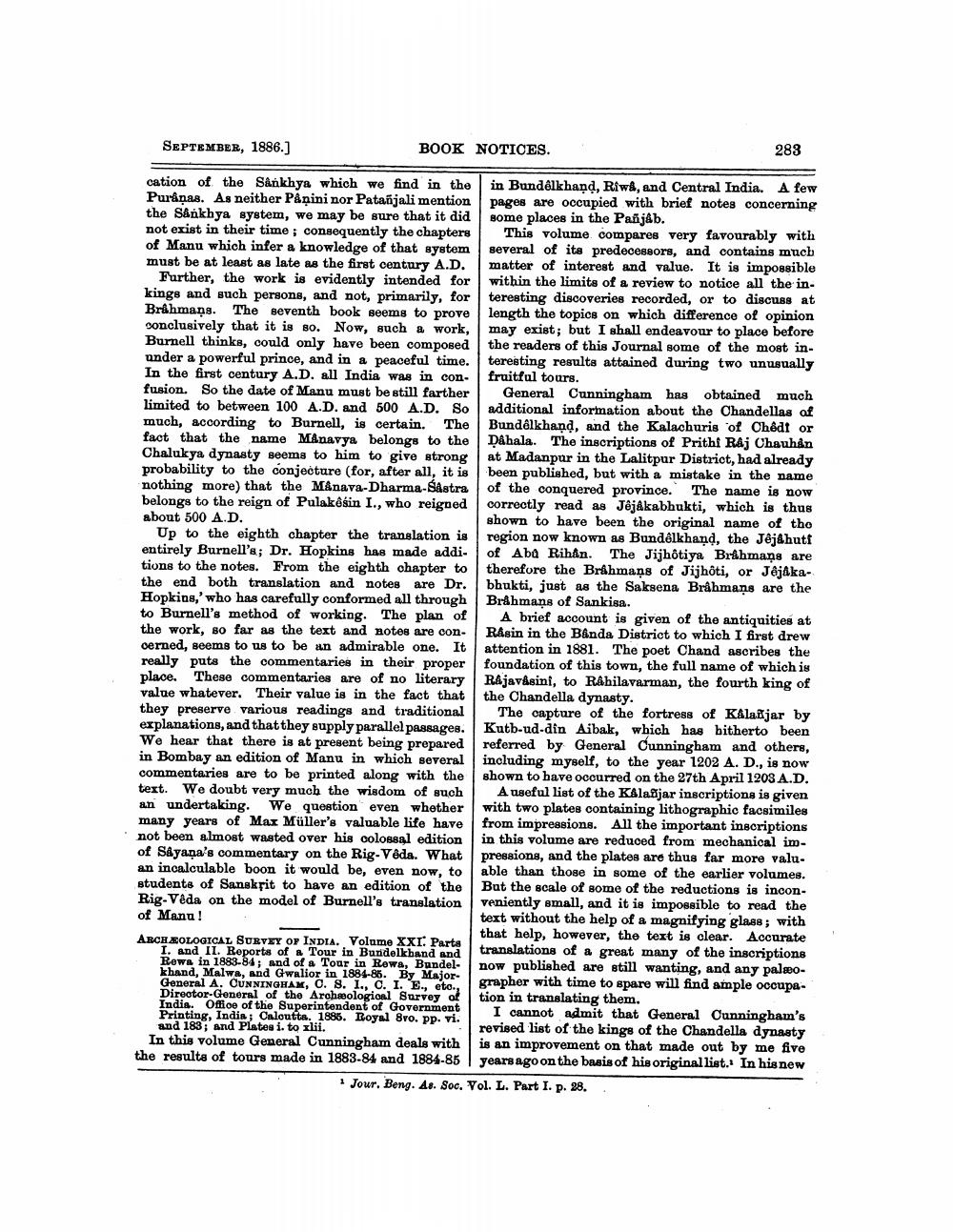________________
SEPTEMBER, 1886.]
BOOK NOTICES.
283
cation of the Sankhya which we find in the in Bundelkhand, Riwa, and Central India. A few Puriņas. As neither Pånini nor Patañjali mention pages are occupied with brief notes concerning the Sankhya system, we may be sure that it did some places in the Panjab. not exist in their time; consequently the chapters This volume compares very favourably with of Manu which infer a knowledge of that system several of its predecessors, and contains much must be at least as late as the first century A.D. matter of interest and value. It is impossible
Further, the work is evidently intended for within the limits of a review to notice all the inkings and such persons, and not, primarily, for teresting discoveries recorded, or to discuss at Brahmaņg. The seventh book seems to prove length the topics on which difference of opinion conclusively that it is so. Now, such a work, may exist; but I shall endeavour to place before Burnell thinks, could only have been composed the readers of this Journal some of the most inunder a powerful prince, and in a peaceful time. teresting results attained during two unusually In the first century A.D. all India was in con- fruitful tours. fusion. So the date of Manu must be still farther General Cunningham has obtained much limited to between 100 A.D. and 500 A.D. So additional information about the Chandellas of much, according to Burnell, is certain. The Bundelkhand, and the Kalachuris of Chêdt or fact that the name Manavya belongs to the Dahala. The inscriptions of Prithi Raj Chauhan Chalukya dynasty seems to him to give strong at Madanpar in the Lalitpur District, had already probability to the conjecture (for, after all, it is been published, but with a mistake in the name nothing more) that the Månava-Dharma-Sastra of the conquered province. The name is now belongs to the reign of Pulakêśin I., who reigned correctly read as Jêjákabhukti, which is thus about 500 A.D.
shown to have been the original name of tho Up to the eighth chapter the translation is region now known as Bundólkhand, the Jejahuti entirely Burnell'a; Dr. Hopkins has made addi. of Aba Rihån. The Jijhotiya Brahmans are tions to the notes. From the eighth chapter to therefore the Brahmans of Jijhoti, or Jejakathe end both translation and notes are Dr. bhukti, just as the Saksena Brahmans are the Hopkins,' who has carefully conformed all through Brahmans of Sankisa. to Burnell's method of working. The plan of A brief account is given of the antiquities at the work, so far as the text and notes are con. Råsin in the Banda District to which I first drew cerned, seems to us to be an admirable one. It attention in 1881. The poet Chand ascribes the really puts the commentaries in their proper foundation of this town, the full name of which is place. These commentaries are of no literary R&javasini, to Rahilavarman, the fourth king of value whatever. Their value is in the fact that the Chandella dynasty. they preserve various readings and traditional The capture of the fortress of Kalajjar by explanations, and that they supply parallel passages. Kutb-ud-din Aibak, which has bitherto been We hear that there is at present being prepared referred by General Cunningham and others, in Bombay an edition of Manu in which several including myself, to the year 1202 A. D., is now commentaries are to be printed along with the shown to have occurred on the 27th April 1203 A.D. text. We doubt very much the wisdom of such A useful list of the KAlažijar inscriptions is given an undertaking. We question even whether with two plates containing lithographic facsimiles many years of Max Müller's valuable life have from impressions. All the important inscriptions not been almost wasted over his colossal edition in this volume are reduced from mechanical imof SÂyana's commentary on the Rig Veda. What pressions, and the plates are thus far more valu. an incalculable boon it would be, even now, to able than those in some of the earlier volumes. students of Sanskrit to have an edition of the But the scale of some of the reductions is inconRig Veda on the model of Burnell's translation veniently small, and it is impossible to read the of Manu!
text without the help of a magnifying glass; with
that help, however, the text is clear. Accurate ARCHXOLOGICAL SURVEY OF INDIA. Volume XXI. Parta I. and Il. Reports of a Tour in Bundelkhand and
translations of a great many of the inscriptions Rewe in 1883-84; and of a Tour in Rewa, Bundel- now published are still wanting, and any paleokhand, Malwa, and Gwalior in 1884-86. By Major. General A. CUNNINGHAM, 0. 8. 1., c. I. E., eto,
grapher with time to spare will find ample occupaDirector-General of the Aroheological Survey of tion in translating them. India. Office of the Superintendent of Government Printing, India; Caloutta. 1886. Royal 8vo. Pp. vi.
I cannot admit that General Cunningham's and 183; and Plates i. to zlii.
revised list of the kings of the Chandella dynasty In this volume General Cunningham deals with is an improvement on that made out by me five the results of tours made in 1883-84 and 1884-85 years ago on the basis of his original list. In his new
* Jour. Beng. As. Soc. Vol. L. Part I. p. 28. .




